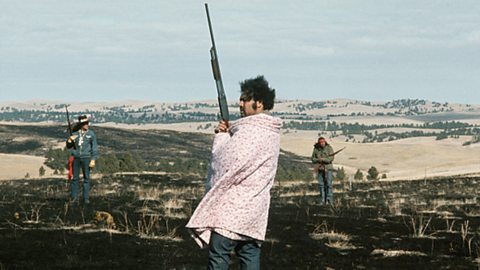The fight for Native American civil rights
The American Indian Movement
As a response to the discrimination experienced by Native Americans, the American Indian MovementAIMAmerican Indian Movement. An organisation created in 1968 to address issues of poverty and discrimination against Native Americans. was founded in 1968. High levels of arrests by police, low education results and physical attacks on their community prompted Native Americans to come together. Some of their aims included:
- establishing a housing programme
- creating a programme to improve education
- creating a programme to increase Native American employment
- improving communications and relations between Native Americans and the rest of American society
Radical protests under the American Indian Movement
The AIM and individual campaigners turned to more radical protest methods towards the end of the 1960s.
Vine Deloria
Vine Deloria published his book Custer Died for Your Sins in 1969. Deloria belonged to the Sioux tribe and used his book to attack the American governmentâs policy towards Native Americans. The title of the book linked the issues of the 1960s with the Indian Wars of the 1860s, which saw the US government break treaties with Native Americans to gain financial benefits. Deloriaâs aim of encouraging an uprising against the government took inspiration from the Black PowerA movement in support of rights and political power for black people. movement.
Occupation of Alcatraz, 1969
The island of Alcatraz became famous in the 20th century for its high-security prison. By 1969 it had become a well-known tourist attraction. In November 1969 approximately 100 Native Americans entered the island and refused to leave until the government allowed them to purchase the island on behalf of all Native Americans, for the cost of $24. The price was symbolic as this was how much the Europeans had paid Native Americans for New York in the 1600s. The occupation lasted for 19 months and ended with the remaining small group of Native Americans being forcibly removed by the Federal Bureau of InvestigationFBIFederal Bureau of Investigation. An agency set up by the US federal government to investigate criminal cases, where federal laws may have been broken.
March on Washington, 1972
In 1972, AIM members travelled to Washington, DC, to meet President Nixon and various government departments to discuss the inequality experienced by Native Americans across America. Upon learning that Nixon wasnât in the country and that the government departments had cancelled their meetings, the AIM members stormed into the Bureau of Indian Affairs building and occupied it for a week. Media attention to the event increased when the AIM constructed a tipi outside the building. The tipi was the traditional home of the Native Americans, made from animal skins to create a portable tent. Eventually Nixon agreed to hear the concerns of the AIM and funded their travel home.
Occupation at Wounded Knee, 1973

The Wounded Knee Massacre of 1890 saw hundreds of Native Americans of the Lakota Sioux tribe murdered by the US Army. The AIM chose a trading post at Wounded Knee for an occupation in 1973 because of its symbolism and also because of the poverty experienced by the Native American residents of the area. The AIM hired lawyers to try to find a legal method of regaining land from the government. It also used the occupation to attract media attention and public sympathy. During the occupation, two Native American people were killed by government agent gunfire and many others were wounded. After 71 days, the occupation ended as the government promised to listen to the complaints of the AIM.
Impact of radical protest
One impact of the protests was to increase public awareness of discrimination against Native Americans. The media attention given to the occupations created sympathy in society. These radical protests had a range of aims, mostly centred on the government returning lands previously owned by Native Americans.
The response from the government was limited. However, there were some changes directly related to the radical protests:
- During the Occupation of Alcatraz, President Nixon returned Blue Lake and 48,000 acres of land in New Mexico to the Taos Indians.
- The 1975 Indian Self-Determination and Education Assistance Act formalised the ending of US policy to integrate Native Americans into US society and culture. It also guaranteed that Native Americans could be self-governing with US government funding.
- The 1978 Indian Child Welfare Act meant that any Native American child who had to be removed from their parents would be dealt with by Native American governments and wouldnât be forced to leave their territory.
More guides on this topic
- Anti-Communism c.1945-1954 - OCR A
- African Americans c.1945-1954 - OCR A
- Civil rights in the USA 1954-1964 - OCR A
- Broadening of the campaigns for civil rights - Women's rights - OCR A
- Broadening of the campaigns for civil rights - Gay rights - OCR A
- Politics and protest - OCR A
- Social problems and attempts to tackle them - OCR A